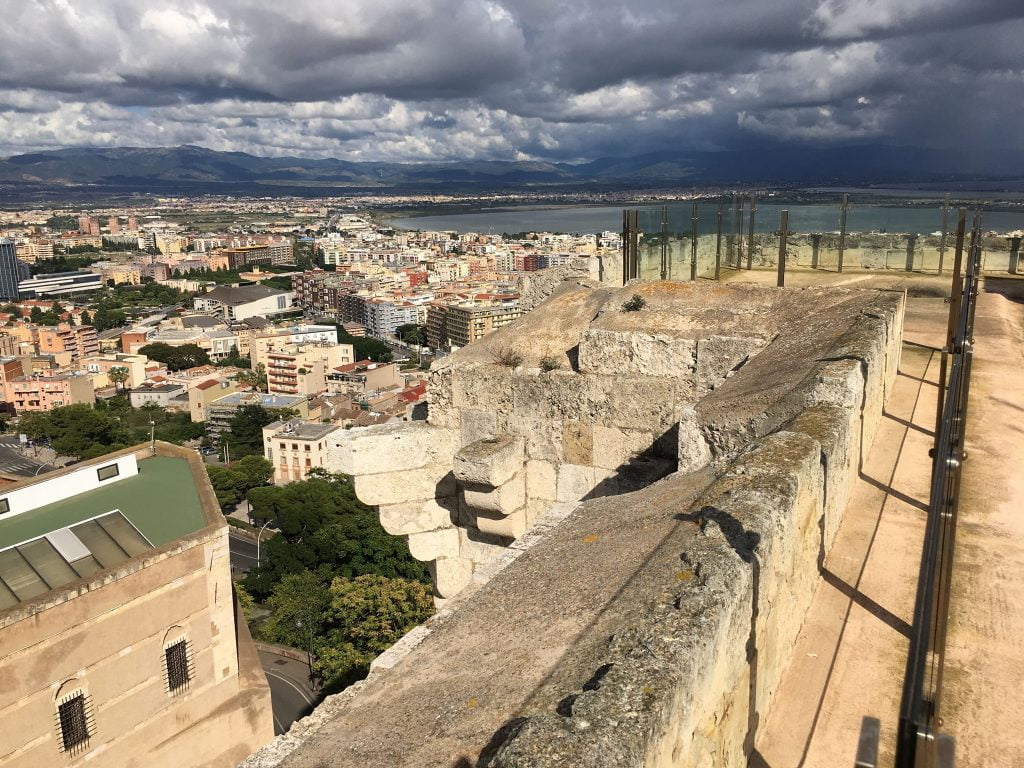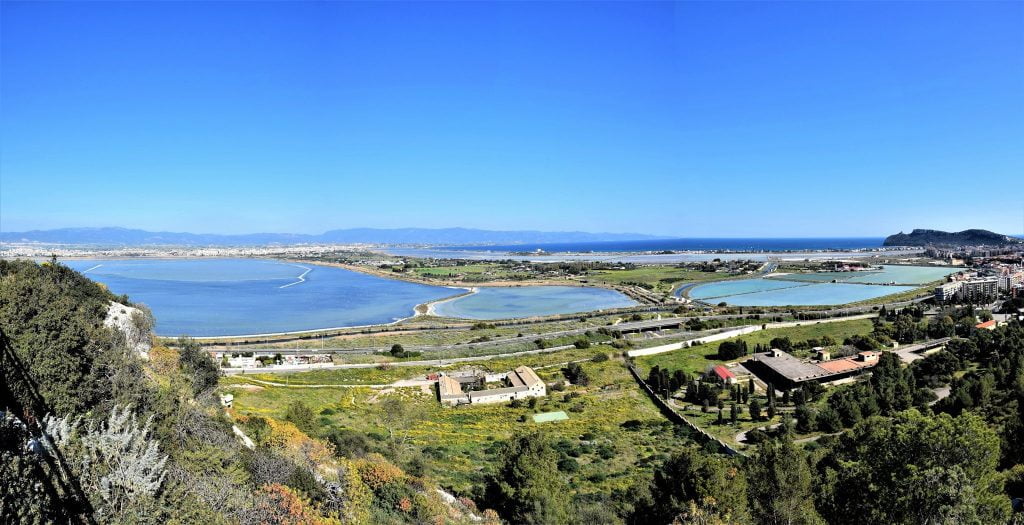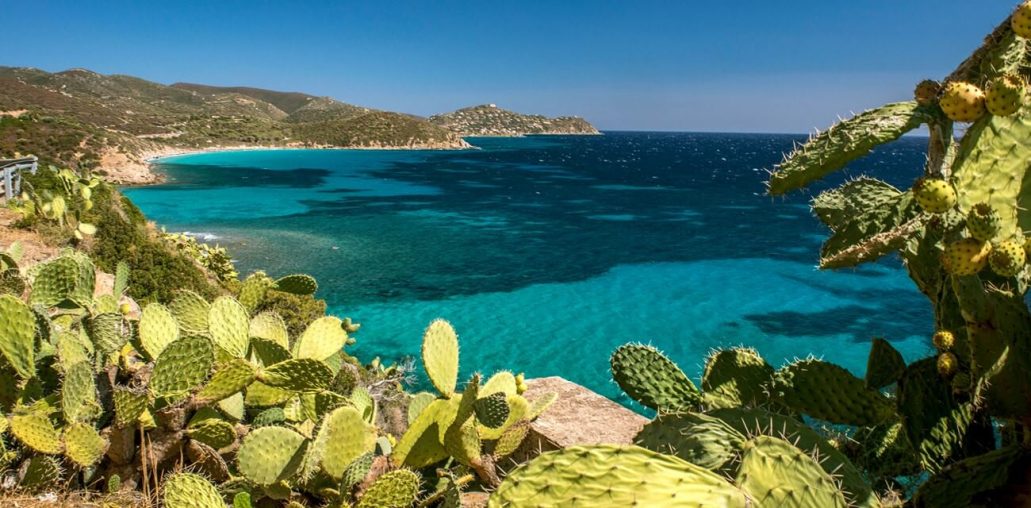13 Best Things to Do in Cagliari, Italy
Cagliari, the capital city of Sardinia, has a rich history that spans many centuries. It was founded by the Phoenicians, colonized by the Carthaginians, occupied by the Romans, and ruled by various groups such as the Pisans, Spaniards, and the Piedmontese. As a result, Cagliari has a diverse cultural heritage encompassing many traditions from different eras.
Things to do in Cagliari
Cagliari’s historic Castello district

At the top of the hill “Il Castello” (The Castle), in a dominant position over the city, there is the fortified citadel with its white walls and high medieval towers. The district of “Il Castello” is the oldest one in Cagliari and being one of the 4 historic districts; it brings together the main things to see in the city, such as the Cathedral of Cagliari or the Bastion of Saint Remy.
This neighborhood located on a hill in the past was home to Sardinian nobles and wealthy people. Fortified over time, in particular by the Pisans, the Aragonese, and the Spaniards, it was the headquarters of the military, religious and civil authorities.
However, the other districts of the city are equally characteristic and rich in historical-artistic testimonies. In addition to history and culture, Cagliari also offers many natural wonders: lagoon areas populated by numerous species of birds, green parks and beautiful beaches that during the summer season come alive day and night giving relaxation and fun.
Bastion of Saint Remy

The visit of the city can start from one of its most known and characteristic monuments: the Bastion of Saint Remy, built between 1896 and 1902 on the ancient Spanish bastions to connect the castle to the lower city.
To get there, take the stairs located in Costituzione Square, or the lift located in the “Sotto le Mura” Garden.
The bastion, made of granite and limestone, includes a staircase formed by two ramps that join in a landing which leads to the covered walkway, a vast painted environment closed by large arches. Today, after years of neglect and abandonment, it has returned to shine as an exhibition space.
A second staircase with two circular ramps placed under an arch leads to the large terrace “Umberto I”, once the favorite walk of the people of Cagliari, today home to a second-hand Sunday market, which offers a splendid view of Cagliari and the Gulf of Angels.
From here, a short staircase leads to a second (smaller) square, dedicated to Saint Catherine. Partially destroyed by the bombings of 1943, the imposing complex was rebuilt after the war according to the original design.
The “Sotto Le Mura” Garden is located under the ramparts and is an excellent place to rest in the shade for a while. From here you can also take the lift to reach the Saint Remy Bastion.
San Pancrazio and the Elephant towers

The San Pancrazio and the Elephant towers, built in the ancient quarter of the “Castle”, were part of the fortified system built by the Pisans in the 14th century against a potential attack by the Aragonese.
Erected respectively in 1305 and 1307 as sighting points, the two twin towers are made of white limestone. The Tower of San Pancrazio, built on the highest point of the hill, consists of four floors with a height exceeding 36 m.; its three massive doors protected the north entrance of the Castle.
Born for military purposes, over time, the tower was used for other functions, as a warehouse during the Aragonese rule in the 14th century and prison in the 17th century. With its 30 m., the Elephant Tower, so named for the small elephant carved in the stone that protrudes from one side of it, instead protected the south-western side of the Castle.
The tower, which has preserved until today the function of entry into the Castle, is one of the most important symbols of the district. But originally, it has been a defensive bulwark, a warehouse, a powder magazine, an armory, and a prison; thanks to the restoration works of the twentieth century, it is possible to admire the two buildings in their original appearance.
Cagliari Cathedral

We continue the tour of the city until we reach Piazza Palazzo, where we find the Cathedral of Cagliari, built during the XII century in Pisan Gothic style and dedicated to Saint Mary and Saint Cecilia.
Enlarged between the end of the XIII and the beginning of the XIV century, in 1669 the religious building was remodelled in the typical forms of the Genoese Baroque. In the first half of the twentieth century, the Baroque facade was redone in Romanesque style with limestone and the two medieval chapels hidden by previous renovations were recovered: the Pisan chapel and the Aragonese chapel of the SS. Sacrament dedicated to the Holy Thorn. Only a few parts of the original 13th-century church remain, including the bell tower.
Among the treasures of the Cathedral are the pulpits dating back to the mid-twelfth century, the sixteenth-century polyptych of the Annunziata, and the medieval wooden sculpture of the Madonna and Child from the Venetian school.
Do not miss the crypt-sanctuary under the presbytery built-in 1618 to honor the remains of Sardinian martyrs. The shrine carved into the rock consists of three chapels with a barrel vault covered with inlaid polychrome marbles and embellished with Sicilian-style baroque stucco decorations. In the crypt, it is possible to see the relics of the 179 martyrs found during excavations near the Basilica of San Saturnino and also some tombs belonging to the Savoy dynasty.
Also in Piazza Palazzo, in addition to the Cathedral, we find the Royal Palace and the Episcopal Palace. The Royal Palace was the residence of the viceroy of Sardinia and is today the seat of the prefecture.
Cagliari churches
When visiting Cagliari, there are a variety of churches you can explore beyond the Cathedral. These include the church of San Michele, constructed to honor Charles V, the church of Santa Anna located in the Stampace district, the church of Sant’Efisio devoted to the patron saint of Cagliari, as well as the churches of San Sepolcro and San Lucifero in the Villanova district.
Shrine of Our Lady of Bonaria

Another religious monument to visit is certainly the Sanctuary of Bonaria, built in the fourteenth century by Alfonso of Aragon as a sign of gratitude following the victory over the Pisans.
The church, in the Catalan-Gothic style, is dedicated to the SS. Trinity and the Virgin. In fact, it preserves a medieval statue of the Madonna and Child venerated by the faithful and invoked by sailors as their protector. The considerable influx of pilgrims led the friars to think of erecting a larger church.
The works started in 1704 and lasted for very long years until, in 1926, the church was consecrated and obtained the title of Basilica. In 1908, Pope Saint Pius X proclaimed Our Lady of Bonaria patroness of Sardinia.
Old Town Hall (Antico Palazzo di Città)

The city’s town hall was built in 1896 in white limestone and is a mixture of Catalan Gothic elements and Art Nouveau motifs. The majestic facade is decorated with bronze sculptures (two lions, an eagle with the city shield and three statues symbolizing Agriculture, Industry and Commerce) and has two octagonal turrets, 38 m high. From the courtyard, a large staircase leads to the upper floors where the Council Hall, the boardrooms and offices are located.
National Archaeological Museum in Cagliari

If you love history, the National Archaeological Museum is the best one in Sardinia; it houses a collection of objects from the Neolithic up to the Roman period, including of course the Nuragic civilization with its famous “nuraghi”, symbol of Sardinia.
Here you can also see the famous 2-meter-high Giants of Mont’e Prama statues representing archers and warriors. The bronzes of about 400 hunters, warriors, and goddesses are also exhibited.
The museum is a really good place to learn more about the history of Sardinia over the centuries. The explanations are available in both English and Italian language.
Another museum to visit in Cagliari is the Pinacoteca Nazionale: an art museum boasts a rich collection of paintings, including some made by Sardinian artists.
Cagliari Markets

During your holidays, you can tour the markets and thus discover Sardinian gastronomy and local flavors. The best in town is definitely the San Benedetto market, located in Via Coccu Ortu, the largest food market in Cagliari. Here you will find all kinds of local products, including cheeses and cold cuts. The market is also renowned for its many fish and seafood stalls. The San Benedetto market is open every day except Sunday, from 7 to 14
Read also: Famous Historic Markets in Italy
Poetto beach

For sea lovers, instead, the “Poetto” is the most famous beach in Cagliari: eight kilometers of sand that stretch from the Sella del Diavolo promontory to the coast of Quartu Sant’Elena.
The construction of the tramway and the rise of the first bathing establishments in the early decades of the 1900s prompted the population to frequent this beach with emerald green water and fine white sand.
Poetto is therefore still today a beautiful beach, perfect for sunbathing and swimming, playing sports in the open air, spending summer evenings among aperitifs, music and shows.
Molentargius – Saline Regional Natural Park

The luxuriant nature of this area is also evident in the nearby Molentargius – Saline Regional Natural Park, a wetland of international value, especially as a habitat for numerous species of water birds, a stone’s throw from Cagliari.
The nature reserve is linked to the long history of the town’s salt pans and to the donkeys (“molenti” in Sardinian language) used in the past to bring the salt collected from the salt pans to the port. The naturalistic complex which extends for about 1600 hectares includes freshwater basins, water with different degrees of salinity and a plain of sandy origin.
Thanks to the different ecosystems that compose it, the Park boasts a rich variety of plant and animal species, many of which are protected. In particular way, the site is famous for the presence of pink flamingos that nested here. The park is housed in a former salt warehouse building: an example of industrial architecture dating back to the 1930s.
Costa Rei

Not far from Cagliari we also meet the splendid landscape that distinguishes Costa Rei: eight kilometers of beautiful beaches that follow one after the other in the south-eastern part of the island, from Capo Ferrato to Cala Sinzias.
Here we find turquoise waters, large expanses of white sand, a lush Mediterranean scrub, dunes drawn by the wind and imposing cliffs. In 2009 the Costa Rei beach was included by the Lonely Planet among the 10 most beautiful beaches in the world. Equally striking are Cala Sinzias, among the most pristine beaches; Cala Pira, one of the most beautiful stretches of the coast and Piscina Rei with its natural pools.
In a short time Costa Rei has become one of the most popular tourist areas in Sardinia, a sort of holiday village made up of villas, hotels, shops, restaurants, discos.
Read also: Best Beaches in Sardinia
Piazza Palazzo

Piazza Palazzo was the beating heart of Cagliari during the Middle Ages.
It houses some of the most important monuments of the town: the Cathedral with its majestic bell tower, the Former Town Hall (Palazzo di Città), seat of the municipality from the Middle Ages to the end of the 19th century, the Archbishop Palace and the Royal Palace, the residence of the Aragonese, Spanish and Piedmontese viceroys and seat of the Savoy royal family between 1799 and 1815.
Cagliari Foods
What makes the city’s cuisine unique are the strong flavors, the tradition, the quality of the raw materials typical of the area, and the Catalan and Ligurian influences.
Starting from appetizers, bread has a fundamental role: the most famous is “carasau”, introduced by the Arabs in the 9th century, excellent with olive oil and salt (pane guttiau); more elaborate in the “frattau” version (with tomato sauce, pecorino cheese and eggs). Among the cheeses we naturally mention the Sardinian specialty par excellence: pecorino, as well as fresh, creamy or smoked cheeses.
Among the first courses, we have the “malloreddus” (semolina and saffron dumplings seasoned with tomato and cheese); the “fregula”, similar to couscous, often served in fish broth, and the “culingionis” (ravioli stuffed with pecorino, potatoes, garlic and mint seasoned with tomato sauce), typically Sardinian. Spanish influences are instead evident in the “cassola” (a fish soup) and “panadas” (calzones stuffed with meat or vegetables). Famous are also the roast wild boar and game, kid, lamb and “porceddu” (suckling pig) on the spit.
The products of the sea are also delicious, such as the “burrida” (fish cooked and marinated in a sauce of walnuts, garlic and parsley), “cocciuta” (clams) and “cozzas” (mussels). And to conclude the desserts. Among the best known: “pardulas”, cheese-based sweets; the “candelaus”, balls of orange almond paste; “seadas”, ravioli filled with cheese, fried and covered with honey.
Finally we also remember the Sardinian wines, including Nuragus (white), Monica (red), Moscato and Malvasia.







